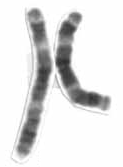3q29 Microdeletion Syndrome

3q29 microdeletion syndrome (also known as 3q29 deletion syndrome) is a condition that results from the deletion of a small piece of chromosome 3 in each cell. The deletion occurs on the long (q) arm of the chromosome at a position designated q29.
The features associated with 3q29 microdeletion syndrome vary widely. Some individuals with this chromosomal change have very mild or no related signs and symptoms, and the deletion is discovered through genetic testing only after a family member is diagnosed. However, most people with a 3q29 microdeletion have delayed development (particularly speech delay) and mild or moderate intellectual disability. They also have an increased risk of behavioral or psychiatric disorders, including autism spectrum disorder (which affects social interaction and communication), anxiety, bipolar disorder, and schizophrenia.
Infants with 3q29 microdeletion syndrome often have feeding difficulties and do not grow and gain weight at the expected rate (which is described as failure to thrive). Weak muscle tone (hypotonia), recurrent ear infections, an unusually small head (microcephaly), and yellowing of the skin and whites of the eyes (jaundice) can also occur. Some affected babies are born with a heart defect, most commonly an abnormal connection between two major arteries called patent ductus arteriosus (PDA).
Other possible features of 3q29 microdeletion syndrome include gastrointestinal disorders, such as a backflow of acidic stomach contents into the esophagus (gastroesophageal reflux), and abnormalities of the teeth. There may also be a subtle pattern of characteristic facial features, including a long, narrow face; a narrow space between the nose and upper lip (short philtrum); a high bridge of the nose; and large ears.
Frequency
3q29 microdeletion syndrome appears to be very rare. Based on a study from Iceland, the condition has an estimated incidence of 1 in 30,000 to 40,000 people in that population. About 75 affected individuals have been described in the medical literature.
Causes
Most people with 3q29 microdeletion syndrome are missing about 1.6 million DNA building blocks (base pairs), also written as 1.6 megabases (Mb), at position q29 on chromosome 3. This deletion affects one of the two copies of chromosome 3 in each cell.
The segment that gets deleted is surrounded by short, repeated sequences of DNA that make it prone to rearrangement during cell division. The rearrangement can lead to missing or extra copies of DNA at 3q29. (An extra copy of this segment causes another condition called 3q29 microduplication syndrome.)
The chromosome segment most commonly deleted in people with 3q29 microdeletion syndrome contains about 20 genes. Some of these genes are thought to be involved in brain development. However, it is unknown which specific genes, when deleted, are related to the signs and symptoms of 3q29 microdeletion syndrome. It is also unclear why some people with a deletion at 3q29 have no associated health problems. It is possible that genetic changes outside the 3q29 region can influence the features of this condition.
Learn more about the chromosome associated with 3q29 microdeletion syndrome
Inheritance Pattern
This condition has an autosomal dominant pattern of inheritance, which means the deletion occurs on one copy of chromosome 3 in each cell.
Most cases of 3q29 microdeletion syndrome result from a new (de novo) chromosomal change and occur in people with no history of the deletion in their family. Less commonly, an affected person inherits the deletion from a parent. The parent may have no signs and symptoms related to the deletion, or the features may be mild.